Congleton, Cheshire
Up to 1834
In 1730, a workhouse was established in the old Lower Chapel in Congleton. By 1810, this building had fallen into a poor condition and the town council decided to build a new workhouse on a leased site on Biddulph Road, High Town — the location is sometimes referred to as Mossley Moor. The cost of the building was about £3,000 and it could house up to 100 paupers.
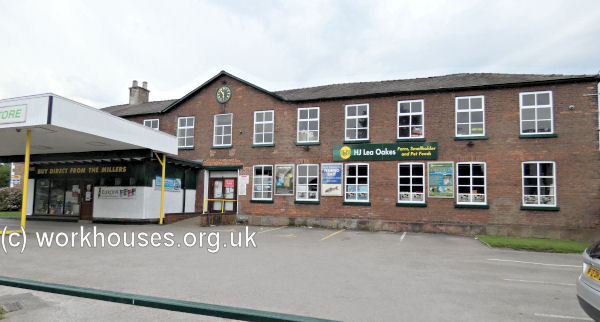
Congleton former High Town workhouse, 2020.
© Peter Higginbotham
A Biddulph parish workhouse accommodating nearly 100 inmates was in operation at Gillow Heath. The building is home to the Staffordshire Knot pub.
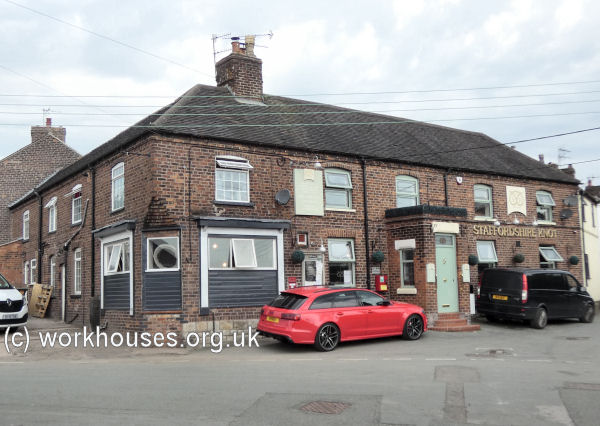
Former Biddulph workhouse, 2020.
© Peter Higginbotham
Sandbach had two small adjacent poorhouses on a site now occupied by almshouses. There were also poorhouses in operation at Betchton Heath.
After 1834
The Congleton Poor Law Union formally came into being on 13th January 1837. Its operation was overseen by an elected Board of Guardians, 34 in number, representing its 31 constituent parishes as listed below (figures in brackets indicate numbers of Guardians if more than one):
County of Chester:
Alsager, Arclid, Betchton, Blackden, Bradwell, Brereton-cum-Smethwick, Buglawton, Church Hulme, Church Lawton Congleton (3), Cotton, Cranage, Davenport, Elton, Hassell, Hulme Walfield, Kermincham, Leese, Moreton-cum-Alcumlow, Moston, Newbold Astbury, Odd Rode, Smallwood, Sandbach (2), Summerford-cum-Radnor, Summerford Booths, Swettenham, Tetton, Twenlow, Wheelock.
County of Stafford:
Biddulph.
The population falling within the union at the 1831 census had been 26,277 with parishes ranging in size from Arclid (population 75) to Congleton itself (9,352). The average annual poor-rate expenditure for the period 1834-36 had been £7,072 or 5s.4d. per head of the population.
The new Board of Guardians initially considered enlarging the existing Congleton parish workhouse to accommodate 300. However, Congleton's location was felt by some not to be central enough. In the meantime, the Union arranged to lease the Congleton workhouse for use by the Union for the sum of £80 per annum. This took place in June 1837 with the existing matron being retained and a new governor appointed. Some small alterations were also made to the building. The workhouses at Sandbach and Betchton Heath also seem to have continued in use, but Biddulph appears to have closed. Disagreement between those wanting to expand the existing Congleton site, and those wanting to build a new, more centrally located, workhouse continued until January 1844 when a site was acquired at Arclid Heath, next to the Rose and Crown Inn.
In 1842, the Congleton Board of Guardians were highly disturbed by news from the nearby union of Wrexham. It was claimed that the prevailing practice of allowing young men to pay night-time visits to female servants in agricultural areas of the Wrexham union was responsible for most of single mothers in residence at the Wrexham workhouse. The Congleton Guardians then began a campaign to ban such visits within the Congleton union and a form of agreement was produced to support the scheme.
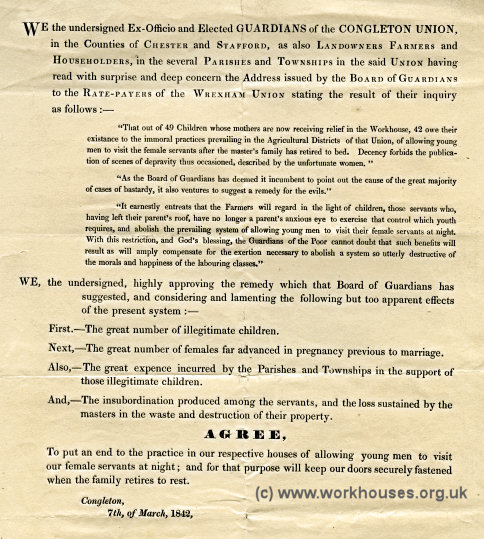
The form issued in 1842 to ban night-time visits to female servants.
© Peter Higginbotham
The new workhouse at Arclid was designed by Henry Bowman and built in 1844-5 at a cost of £7,097. It was intended to accommodate 370 inmates. It comprised three main sections: an entrance block containing porter's lodge and board-room, a long main block of two and three storeys, and a two-storey infirmary to the rear. The central section of the main block contained a dining hall at the front with the kitchens and laundry to its rear. To each side of the dining hall were schoolrooms, for girls at the north and boys at the south.
In 1847, increasing concern at the lack of separate accommodation for fever cases led to the creation of a separate fever ward. This was achieved by the modest expenditure of £85 on roofing over two washhouses in the girls' yard.
The original infirmary block had 26 beds, 13 for men and 13 for women. It was extended in 1860 and again in 1873 to increase its capacity to 58. However, this still proved insufficient to meet the growing demands and in 1899-1900 a new infirmary was erected at the north of the workhouse. Designed by Alfred Price, it had 100 beds and accommodation for nurses. The total cost was over £6,000 — £4,650 for the building, £1,250 for the boiler room in its basement, and £400 for furnishing the building.
The workhouse's location and layout can be seen on the 1908 map below.
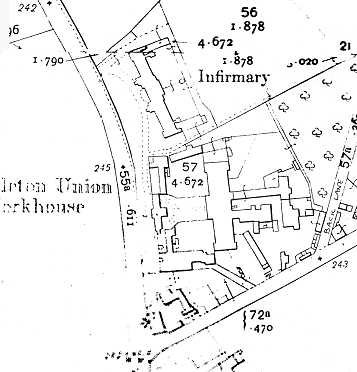
Congleton workhouse site, 1908.
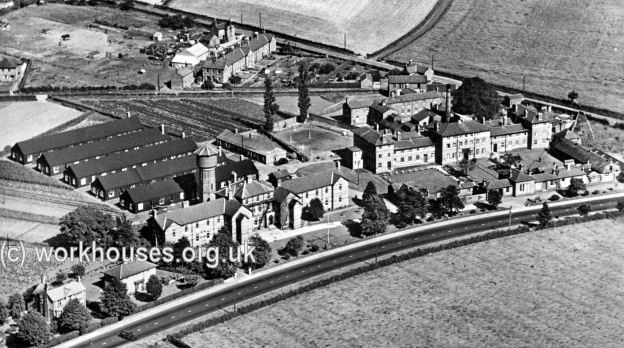
Congleton workhouse site aerial view from the north-west, date unknown.
© Peter Higginbotham
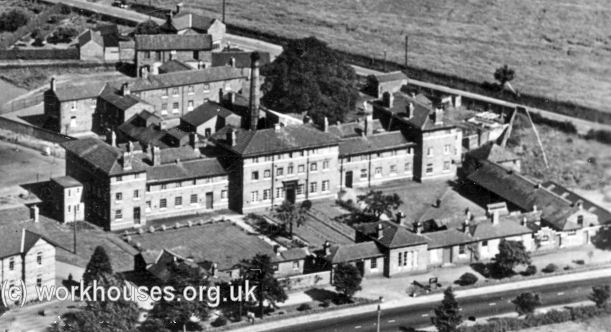
Congleton aerial view — detail.
© Peter Higginbotham
In 1872, the union increased its provision for vagrants. At Arclid, new tramp wards were erected at the south-west corner of the site. A new casual ward was also erected in Park Street, Congleton.
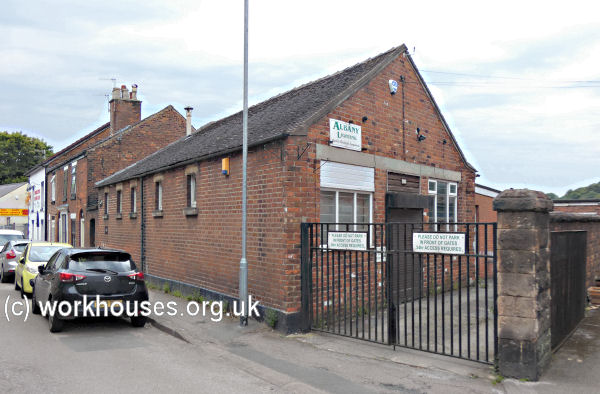
Former Park Street casual ward, Congleton, 2020.
© Peter Higginbotham
During the First World War, 40 beds in the infirmary were given over for the care of military casualties. In addition, 20 pauper inmates were taken in from the Wirral Union workhouse which was also being used as a military hospital. In September 1918, the casual ward in Congleton, which had been closed the previous year, were used to accommodate 10 German prisoners of war who were employed in agricultural work in the area.
During the 1920s, the use of the infirmary as a general and maternity hospital gradually increased. Then, with the abolition of the workhouse system in 1930, it became officially known as Congleton Public Assistance Institution. During the 1930s, the hospital became mainly used for geriatric care and took on the name Arclid Hospital.
Arclid Hospital closed in the spring of 1993 and the buildings all demolished.
Staff
Inmates
Records
Note: many repositories impose a closure period of up to 100 years for records identifying individuals. Before travelling a long distance, always check that the records you want to consult will be available.
- Cheshire Archives and Local Studies, Cheshire Record Office, Duke Street, Chester, Cheshire CH1 1RL. Holdings include Guardians' minutes (1837-1930); Ledgers (1850-1923); Births (1914-49); Baptisms (1902-51); Deaths (1837-1963); Creed registers (1901-48); etc.
Bibliography
- At the Crossroad. A History of Arclid Workhouse and Hospital. by Marlene and Graham Langley (1993).
Links
- None.
Unless otherwise indicated, this page () is copyright Peter Higginbotham. Contents may not be reproduced without permission.


